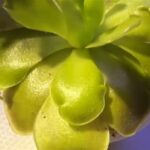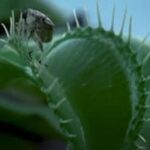As an Amazon Associate, this site earns commissions from qualifying purchases. For more details, click here.
Drosera intermedia is a tropical sundew and one of the easiest carnivorous plants to grow. If you are new to this, D intermedia is one that you may want to try. Cultivation is straightforward and even absolute beginners should have no problems raising them to maturity.
The best soil to grow Drosera intermedia is 1:1 silica sand and peat, and the soil must always be moist. Provide as much light as possible, with the ideal temperature between 75 to 80 F and 70-80% humidity.
Drosera Intermedia Care Sheet
| Soil | Long fiber sphagnum or peat, keep soil very damp in summer |
| Water | Distilled, rainwater |
| Light | At least 6 hours of sunlight or indoor grow light |
| Food | Tiny insects, fish food, bloodworms, mealworms |
| Temperature | 70-85 F (21-29 C) |
| Humidity | 60-80% |
| Dormancy | Not needed |
| Propagation | Root cutting, leaf pulling |
What Soil and Pot to Use
Drosera intermedia are best grown with soil that has little to no nutrition. You may use long fibered sphagnum, peat or silica sand. You might try a 2:1 ratio but most of the time 1:1 is going to produce the best result. To keep it simple we suggest a ready made solution like Rio Hamza Trading Carnivorous Plant Soil as it is ideal for all types of predatory plants.
Most sundews flourish in waterlogged conditions so overwatering is unlikely. Very moist soil is ideal during summer where temperatures soar.
D intermedia handles waterlogged soil well and actually thrives in it. Keep the soil damp at all times and it must have good drainage. Just like Drosera venusta these plants cannot grow in fertilized or standard potting soil.
Here is a simple test to find out if the soil is too dry, too damp or just right.
- Press your finger in the soil. If water seeps through, it is too damp.
- If nothing sticks to your finger the soil is too dry.
- If dirt sticks to your finger and feels moist, but does not pull up water, it is just about right.
The pot has to be at least 3 inches as D intermedia grows long roots. These can reach half a foot in length so a deeper container might be necessary. If you opt for a 3 inch pot, keep an eye as the plant grows because it will need repotting. Otherwise the roots are just going to get entangled due to lack of space.
The pot must have good drainage especially if you use the tray method. An inch of water in the tray is ideal for a 3 inch pot, though 1.5 or 2 inches will not hurt. For a mature D intermedia with 6 inch roots, the water level should be half the pot height.
How Much Light Does Drosera Intermedia Need?
While some sundews prefer a bit of shade, this drosera flourishes with light. Drosera intermedia requires at least six hours of light per day. But the more light the plant receives the faster and healthier it grows.
There are several options. You can leave the sundew outdoors in a sunny area. You can keep the plant indoors but set it on a south facing window. Or you can use artificial lights to simulate the intensity of natural light.
There are a lot of artificial lights to choose from, but fluorescent works particularly well with D intermedia and its forms. Place the light fixture close to the plant and leave it on for several hours a day.
Cultivators prefer natural light for sundews but there is nothing wrong with artificial lighting. D intermedia does cannot distinguish between the two. If your drosera is indoors, you can use artificial fixtures like the GroDrow Grow Lights and your sundew will be fine.
You can also combine natural and artificial lighting. If your plant only gets 4 hours of natural light, you can set up a fluorescent light to augment this. You can keep the light running for several more hours. The more light you can provide the better it is for D intermedia.
Drosera intermedia gets nutrients from insects and other prey, but they need light to survive. Is it possible for these plants to get too much light? Unlikely. What they can suffer from is too much heat.
Humidity and Temperature
These two elements are often linked to sunlight but they need to be treated differently. D intermedia thrives in light but it can only grow in a certain temperature range.
You can also create a mini bog if the sundew is outdoors to get the ideal climate. These plants grow in bogs and other watery locations in the wild. By simulating that environment you can speed up its growth.
Drosera intermedia grow fastest when the temperature is no more than 70-85 F (21-29 C). These plants may hibernate if the temperature drops to freezing. For best results they should be grown in a warm location.
If the weather gets too hot you can give the plant shade, but only if it is showing signs of being burned out. Otherwise you should just leave it out there in the sun. Majority of D intermedia handle cold temperature fine, so unless it is freezing they will survive..
The ideal humidity rate is 80% but the plant is fine at 60-70% as well. The higher the humidity the more dew the plant can produce. Light and humidity encourage these plants to produce dew (or mucilage) which in turn allows them to catch more insects. You can check this guide why your sundew is not sticky if you have that problem.
One way to achieve this humidity is to keep D intermedia in a tray of water. The plant absorbs the water and keeps the humidity high.
You should try to keep the humidity and temperature as close to this range as possible. It does not have to be exactly within it, but the nearer to the range the better. A humidity rate of 80% is ideal if you want D intermedia to absorb more insect nutrients.
Intense sunlight is often accompanied by high temperature, and this is where humidity becomes important. You can keep your sundew out in the sun as long as the humidity does not fall below 60%. This will allow the plant to withstand the heat without burning up.
Nutrition and Food
Drosera intermedia only consumes small amounts of food. Too much causes mold to spread. Remove the mold as soon as possible to avoid damaging the plant.
D intermedia eats the same type of insects that other sundews do: flies, spiders, crickets, ants, gnats as well as freeze dried mealworms. You can also give them fish food.
This sundew needs to eat once a week for optimum growth. Keep the food particle small and do not feed unless there is dew on the leaves. All sundews need the sticky stuff to digest food.
Very young D intermedia might not have enough dew yet to digest. Wait until there is a clear sign that dew has formed on the leaves. Do not worry if the food bits seem too small, that is enough for this sundew.
Like other drosera variants, D intermedia feeds on living and dead insects. All you have to do is place the food on the sticky stuff. The leaf will bend eventually and digest it. This could take a long time so do not be impatient.
Dormancy, Reproduction and Propagation
All forms of D intermedia do not need dormancy. They might go into hibernation if the weather gets very cold, but it is not required. This is one of the reasons why this sundew is easy to grow.
A healthy D intermedia grows quickly without any need of assistance. You can propagate through leaf cutting, root cutting and seeds. Tropical D intermedia seeds do not require cold stratification but temperate D intermedia does. Keep this in mind if you are growing from seeds.
Use large leaves for leaf cutting as they have a higher success rate. Snip the leaves and float them on water. As for root cutting, do it only if the plant is healthy. This will only work with long healthy roots.
Conclusion
There are a couple of forms available, D intermedia Cuba and D intermedia Mount Roraima, but culmination is similar. So whichever you get you can use the guidelines to care for them. Even if you are a seasoned grower, having these in your collection is a plus.

My fascination with carnivorous plants began many, many years ago with Venus Fly Traps. Now I am more than happy to impart what I know with other enthusiasts and those who are curious about meat eating plants.



